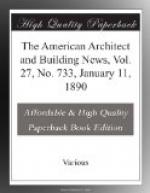much studied for a long time back, and is one which
marches towards a solution which promises to be perfectly
satisfactory in view of the progress already made.
Wide streets have replaced narrow alleys, air circulates
freely everywhere, trees and enormous gardens have
been planted on every side, and the salubrity of the
house is assured by a severe inspection, one which
will become yet more severe, it is to be hoped, in
the case of those owners who are inclined to despise
regulations. It would be so simple in place of
continuing the ancient ways, whose inconveniences are
so well demonstrated in the large model of an unhealthy
house exhibited in the pavilion of the city of Paris,
to adopt all the new systems of sanitation which,
on their part, are shown in application in the model
of a sanitarily perfect house which has been placed
opposite to it. To establish this comparison
two very simple models of construction have been selected,
proving that healthfulness is not merely an attribute
of luxury, but that the most modest houses can present
all possible guaranties from this point of view.
The healthfulness of houses, and consequently of cities,
depends amongst other multiple but relatively simple
causes on two preeminent conditions,—that
of the removal of excrement, and the purity of the
water-supply. In a large degree the first condition
is subordinated to the second. “Everything
to the sewer” is recognized by the most competent
hygienists as the best system, but only on the condition
that water shall be abundant and that no stagnation
of the material shall be allowed. These problems,
which were for a long time studied by M. Durand-Claye,
and to which he devoted himself until his premature
death unfortunately took him from us, have received
the attention of his devoted successors, who have already
brought to fruition interesting solutions which prompt
us to hope for a completely satisfactory system in
the near future.
Three glass reservoirs, containing water from the
Seine, from the Ourcq and the Vanne, allow us to perceive
the difference of quality which exists between these
three sources of supply, the first of which, with
its yellow color, is anything but appetizing, and the
second is not much less doubtful, while the third,
alone, presents the limpidity and transparency which
one has a right to demand in potable water. Nevertheless,
one should not believe, as many persons do, that the
water that we see in this reservoir, and which has
been taken within the limits of Paris, is the same
that is distributed from time to time through each
quarter. The water there used is taken up-stream
and before it has been soiled by its passage through
the suburbs and city.
In the same pavilion the Administration has exhibited
the plans and the comparative views of the city taken
at different epochs since 1789 up to the last months
of 1889. We here see the march of progress in
this immense city, expanding without cessation like
a drop of oil, and as it enlarges crossed by great
arteries which establish across its mass conduits
for aeration, and at the same time suppress the agglomerations
of former days.




